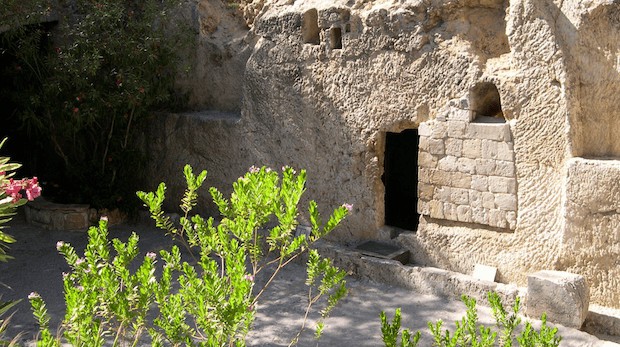Today is Good Friday, and Christians around the world are remembering Christ’s death, caused by our sin.
This year on the blog, we featured a five-week family Easter Bible study written especially for families. We posted one Easter Bible Study each Friday leading up to today. If you missed the first four, we’ve included them below. It’s an excellent opportunity to remember the story the Bible tells about not only Jesus’ death but to celebrate his resurrection—but also challenges families to consider three important questions at the end of each study: Who is God? Who is Jesus? Who are we?
- Read The Last Supper: Family Easter Bible Study—Week 1
- Read Jesus on Trial before Pilate: Family Easter Bible Study—Week 2
- Read Jesus Is Crucified: Family Easter Bible Study—Week 3
- Read Jesus Dies and Is Buried: Family Easter Bible Study—Week 4
***
By Mark Ward
Read Matthew 28:1–10. What did the women who came to Christ’s tomb expect to see?
Soldiers guarding a dead body in a sealed tomb.
What did they see instead?
A shining angel in white clothing.
Why would the angel invite the women to see the place where Jesus’ dead body had been?
To demonstrate to them that this was not a trick. Jesus was really gone from that tomb. They would see him, as the angel said, in Galilee.
How would you have felt if you were one of those women, the first people in history to find out that death had been conquered? (Let kids answer.)
What emotions does the Bible say the women experienced?
“Fear and great joy” (28:8).
How often do these emotions go together?
What did the women fear, and what were they joyful about?
They feared because something truly great had happened—and it opened up many unknowns. They rejoiced because their Lord had not been conquered by death, but rather the opposite.
Who were the first people to see Jesus alive after his resurrection? How did they respond to seeing him alive?
The women saw him first. They fell at his feet and grabbed them!
Read Matthew 28:11–15. Why did the Jewish leaders pay the Roman soldiers to lie?
At the resurrection, a great miracle occurred—the greatest and most important miracle in the history of mankind. The Jewish leaders had to know that the Roman soldiers who came to them with tales of earthquakes and angels (28:11) were telling the truth about that miracle. Otherwise they would not have paid the soldiers to lie (28:13).
The healings Jesus performed, the multiplying of loaves and fishes, the tales of walking on water—all that the Jewish leaders heard failed to convince them that Jesus was the way, the truth, and the life. Sin is so strong in people’s hearts that people can disbelieve even when God shows up with miracles. The truth is that Jesus did rise from the dead, and everyone who follows him will experience that resurrection life.
After Jesus died and rose again, the apostle Paul started churches in cities all around the Roman Empire. One of these churches was in Corinth, and he wrote letters to the Christians there. Read 1 Corinthians 15:1–6, and make a list of the specific events Paul describes in this passage. How many events are part of Paul’s gospel message? What are they?

Each event is part of the gospel message. The first and third are the main points, the second and fourth are supporting points:
(1) Jesus died . . . and (2) he was buried.
(3) Jesus rose . . . and (4) he was seen.
This is the gospel—the good news “by which you are saved” (1 Cor 15:2).
Look again at 1 Corinthians 15:4. Notice how Paul doesn’t just tell the story of Jesus’ resurrection. He also shows the meaning of those events.
What is the meaning of the resurrection? Does Matthew attach the same significance to it?
Paul says the resurrection happened “according to the Scriptures.” In other words, it was predicted in the Old Testament. For example, Isaiah 53 tells of the Suffering Servant who suffers for our sins.
The Gospel of Matthew is a story, not an explanation. It does not say much about the meaning of the resurrection. It does, however, provide a hint: it tells how even a Roman centurion concluded from the miraculous events he had seen that Jesus truly was the Son of God (Matt 27:54).
Read Matthew 28:18–20. Matthew’s Gospel ends with the words of Jesus’ Great Commission. Jesus’ resurrection is a sign of the authority he has been given in heaven and on earth.
What does Jesus tell his followers to do? Why did Matthew choose to finish his story of Jesus this way?
Jesus sends his disciples out into the world to teach people everywhere to follow him. And that is our mission, too.
Who is God?
The one whose power raised Jesus from the dead.
Who is Jesus?
The risen Son, the one who experienced death and defeated it.
Who are we?
We are followers of the Risen Lord. We are sent into all the world to spread the message of Jesus and encourage people to follow him. And one day, we will be raised to new life with Jesus, to live in God’s presence forever.
***
- Read The Last Supper: Family Easter Bible Study—Week 1
- Read Jesus on Trial before Pilate: Family Easter Bible Study—Week 2
- Read Jesus Is Crucified: Family Easter Bible Study—Week 3
- Read Jesus Dies and Is Buried: Family Easter Bible Study—Week 4
This post has been adapted from the original article by Mark Ward in the March 2020 issue of Bible Study Magazine.
Mark Ward is an academic editor at Lexham Press and the author of multiple high school Bible textbooks, including Biblical Worldview: Creation, Fall, Redemption. His latest book is Authorized: The Use and Misuse of the King James Bible (Lexham Press, 2018).






